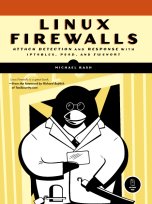Free Linux Firewalls Book Chapter
03 November, 2007

 No Starch Press has posted
Chapter 10: Deploying fwsnort
for free download on their
site. This chapter concentrates on the application of fwsnort
to iptables rulesets, as mentioned in the chapter introduction:
No Starch Press has posted
Chapter 10: Deploying fwsnort
for free download on their
site. This chapter concentrates on the application of fwsnort
to iptables rulesets, as mentioned in the chapter introduction:
 With the theoretical
discussion in Chapter 9 on the emulation of Snort rule options within iptables
behind us, we'll talk in this chapter about how to get fwsnort to actually do
something! Namely, we'll discuss the administration of fwsnort and illustrate
how it can be used to instruct iptables to detect attacks that are associated
with the Snort signature ruleset.
With the theoretical
discussion in Chapter 9 on the emulation of Snort rule options within iptables
behind us, we'll talk in this chapter about how to get fwsnort to actually do
something! Namely, we'll discuss the administration of fwsnort and illustrate
how it can be used to instruct iptables to detect attacks that are associated
with the Snort signature ruleset.
When fwsnort is executed from the command line with no restrictive arguments to limit the scope of the translation process, the default output displays the success and failure rates for translating Snort signatures as seen below. Not all Snort signatures can be re-cast into an iptables rule because of complexities (such as PCRE's) that cannot (yet) be handled within iptables, but as you can see fwsnort achieves a 60% translation rate for the Snort-2.3.3 ruleset - this is more than sufficient to catch a lot of malicious traffic.
[iptablesfw]# fwsnortThe chapter goes on to give several specific attack examples, and how fwsnort can be used to detect them. Here is an example Bleeding Edge Snort rule for detecting the Dumador Trojan (which affects Windows systems and contains both a keylogger and a backdoor):
Snort Rules File Success Fail Ipt_apply Total [+] attack-responses.rules 15 2 0 17 [+] backdoor.rules 62 7 1 69 [+] bad-traffic.rules 10 3 0 13 [+] bleeding-all.rules 1076 573 5 1649 [+] exploit.rules 31 43 0 74 [+] web-cgi.rules 286 62 0 348 [+] web-client.rules 7 10 0 17 [+] web-coldfusion.rules 35 0 0 35 [+] web-frontpage.rules 34 1 0 35 [+] web-iis.rules 103 11 0 114 [+] web-misc.rules 265 61 0 326 [+] web-php.rules 78 48 0 126 [+] x11.rules 2 0 0 2 2725 1761 91 4486 [+] Generated iptables rules for 2725 out of 4486 signatures: 60.74% [+] Found 91 applicable snort rules to your current iptables policy. [+] Logfile: /var/log/fwsnort.log [+] Iptables script: /etc/fwsnort/fwsnort.sh
alert tcp $HOME_NET any -> $EXTERNAL_NET $HTTP_PORTS (msg:"BLEEDING-EDGE \
TROJAN Dumador Reporting User Activity"; flow:established,to_server; \
uricontent:".php?p="; nocase; uricontent:"?machineid="; nocase; \
uricontent:"&connection="; nocase; uricontent:"&iplan="; nocase; \
classtype:trojan-activity; reference:url,www.norman.com/Virus/ \
Virus_descriptions/24279/; sid:2002763; rev:2;)
By using the fwsnort --snort-sid command line argument, fwsnort will
build an iptables command that detects a specific Snort rule ID, so we use
this to restrict fwsnort's translation process to just the Dumador signature:
[iptablesfw]# fwsnort --snort-sid 2002763
[+] Parsing Snort rules files...
[+] Found sid: 2002763 in bleeding-all.rules
Successful translation.
The result is a rather complicated iptables command that uses the string
match extension multiple times to express the uricontent fields in
the Snort rule. Also, the reference information and the Snort msg
field are stored within the iptables rule with the comment match.
Finally, the FWSNORT_FORWARD_ESTAB iptables chain is used to only
perform the inspection over established TCP connections (the jump rule into
this chain uses the state match):
$IPTABLES -A FWSNORT_FORWARD_ESTAB -s 192.168.10.0/24 -p tcp --dport 80 -m \
string --string ".php?p=" --algo bm -m string --string "?machineid=" --algo \
bm -m string --string "&connection=" --algo bm -m string --string "&iplan=" \
--algo bm -m comment --comment "sid:2002763; msg: BLEEDING-EDGE TROJAN \
Dumador Reporting User Activity; classtype: trojan-activity; reference: \
url,www.norman.com/Virus/Virus_descriptions/24279/; rev: 2; FWS:1.0;" -j LOG \
--log-ip-options --log-tcp-options --log-prefix "[1] SID2002763 ESTAB "




